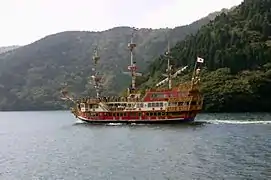Hakone
Hakone (箱根町, Hakone-machi) is a town in Kanagawa Prefecture, Japan. As of June 2012, the town had an estimated population of 13,492, and a population density of 145 persons per km². The total area is 92.82 km2 (35.84 sq mi). Hakone has been designated as a Japanese National Geopark by the Japanese Geoparks Network.
Hakone
箱根町 | |
|---|---|
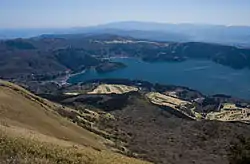 View of Lake Ashi and Hakone Town from Mount Hakone Komagatake | |
 Flag  Seal | |
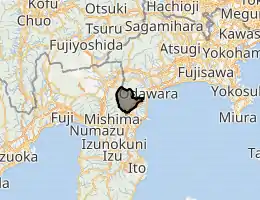
| |
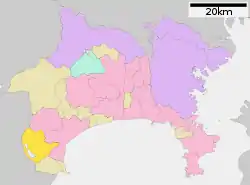 Location of Hakone in Kanagawa Prefecture (golden) | |
 Hakone | |
| Coordinates: 35°11′N 139°02′E | |
| Country | Japan |
| Region | Kantō |
| Prefecture | Kanagawa Prefecture |
| District | Ashigarashimo |
| First official recorded | 700 AD |
| Town Settled | October 29th, 1892 |
| Government | |
| • Mayor | Nobuo Yamaguchi (from November 2000) |
| Area | |
| • Total | 92.82 km2 (35.84 sq mi) |
| Population (June 1, 2012) | |
| • Total | 13,492 |
| • Density | 145/km2 (380/sq mi) |
| Time zone | UTC+9 (Japan Standard Time) |
| - Tree | Yamazakura (Prunus jamasakura) |
| - Flower | Hakonebara (Rosa microphylla hirtura) |
| - Bird | Woodpecker |
| Phone number | 0460-85-7111 |
| Address | 256 Yumoto, Hakone-machi, Ashigarashimo-gun, Kanagawa-ken 250-0398 |
| Website | http://www.town.hakone.kanagawa.jp/ |
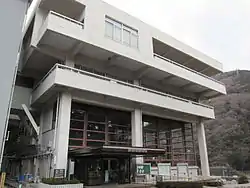
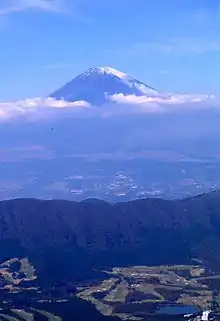
Hakone is to a great degree regarded as a traveler destination; Mount Fuji can be seen when taking a day trip from Tokyo. In addition to hot springs, museums and other recreation activities, Hakone is known for its scenery during all four seasons.[1]
Geography
Hakone is located in the mountains in the far west of the prefecture, on the eastern side of Hakone Pass. Most of the town is within the borders of the volcanically active Fuji-Hakone-Izu National Park, centered on Lake Ashi.
History
Hakone is the location of a noted Shinto shrine, the Hakone Gongen, which is mentioned in Heian period literature. During the Genpei War, Minamoto no Yoritomo prayed at this shrine for victory over his enemies, after his defeat at the Battle of Ishibashiyama, which was fought in neighboring Manazuru. As with the rest of Sagami Province, the area came under the control of the later Hōjō clan of Odawara during the Sengoku period. After the start of the Edo period, Hakone-juku was a post station on the Tōkaidō highway connecting Edo with Kyoto. It was also the site of a major barrier and official checkpoint on the route known as the Hakone Checkpoint (箱根関所, Hakone sekisho), which formed the border of the Kantō region. Under the Tokugawa shogunate, all travellers entering and leaving Edo along the Tōkaidō were stopped here by officials. Their travel permits and baggage were examined to enforce Tokugawa laws that restricted the travel of women and weapons.
After the start of the Meiji Restoration, Hakone became a part of the short-lived Ashigara Prefecture before becoming part of Ashigarashimo District in Kanagawa prefecture in August 1876. Hakone attained town status in 1889. The imperial household established the summer Hakone Imperial Villa close to the lake.
After merger with five neighboring towns and villages in September 1956, it reached its present boundaries.
Economy
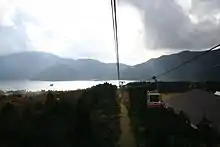
The economy of Hakone is strongly dominated by the tourist industry. Hakone is noted for its onsen hot spring resorts, which attract both Japanese and international visitors, due to its proximity to the greater Tokyo metropolis and to Mount Fuji. Sights include the volcanically active Ōwakudani geysers and Hakone Shrine on the shore of the lake, as well as the Hakone Botanical Garden of Wetlands. In April the cherry blossoms (sakura) and in autumn the Miscanthus sinensis (susuki) are noted sights.
Hakone has a number of art museums, including the Hakone Open-Air Museum and Pola Museum of Art.
Major events include the annual JLPGA CAT Ladies Golf tournament and the Hakone Ekiden, a long distance collegiate foot race, held at the New Year, which runs from Tokyo to Hakone and back over two days, partly in commemoration of the couriers who ran the Tōkaidō road.
One famous hotel in Hakone is the historic Fujiya Hotel in Miyanoshita, which was patronized by noted literary figures, politicians and foreign dignitaries in the Meiji and Taishō and early Shōwa periods.
A noted local handicraft is a kind of marquetry called Yosegi.[2]
Hakone is also well-known among anime fans for being the main location in the manga and anime series Neon Genesis Evangelion, in which it has been renamed Tokyo-3, and there are numerous attractions related to the franchise offered in the town.[3] In 2017, Hakone was included as one of 88 anime pilgrimage sites for 2018 by the Anime Tourism Association.[4][5] In 2020, new decorations have been introduced to the city in the anticipation of the release of the final film of the Rebuild of Evangelion tetralogy.[6]
Transportation
Railway
Odawara and Mishima, the terminus of the Odakyū Odawara Line, 70 minutes from Shinjuku, Tokyo. From Odawara, the Hakone Tozan Line continues into various resort towns in Hakone. Odakyu also runs the Romancecar limited express between Shinjuku and Hakone-Yumoto. From Gōra, the terminus of Hakone Tozan Line, the Hakone Tozan Cable Car funicular goes to Sōunzan. Ōwakudani can be reached by Hakone Ropeway from Sounzan and the lake, while the lake is crisscrossed by cartoonishly decorated "pirate" ships for tourists. There is also Hakone Komagatake Ropeway, which goes to the top of Mount Komagatake.
A popular "Hakone Free Pass", allowing unlimited use of most forms of transport for several days, is available. Hakone Free Pass can be bought at Shinjuku Station, Odawara Station, any other chief station along Odakyū Odawara Line, Hakone-Yumoto Station, Gōra Station, any other chief station along Hakone Tozan Line, Sōunzan Station, Tōgendai Station, Sengoku-Annaijo Bus Stop, Moto-Hakone Port, Hakone-Machi Port, and JR Gotemba Station Bus Information.
Sister cities
 - Tōyako, Hokkaidō, since July 4, 1964
- Tōyako, Hokkaidō, since July 4, 1964.svg.png.webp) - Jasper, Alberta, Canada from July 4, 1972
- Jasper, Alberta, Canada from July 4, 1972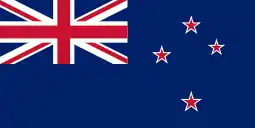 - Taupo, New Zealand, from October 7, 1987
- Taupo, New Zealand, from October 7, 1987 - St. Moritz, Switzerland, from November 2, 2014 (Friendship City)
- St. Moritz, Switzerland, from November 2, 2014 (Friendship City)
Gallery
 Hakone, hand-colored print 1860–1900
Hakone, hand-colored print 1860–1900 Torii of the shrine in Hakone, at Lake Ashi
Torii of the shrine in Hakone, at Lake Ashi Yumoto Onsen, Meiji era
Yumoto Onsen, Meiji era The summer festival in Hakone includes a bonfire in the shape of the kanji 大 (dai) and fireworks
The summer festival in Hakone includes a bonfire in the shape of the kanji 大 (dai) and fireworks Lake Ashi
Lake Ashi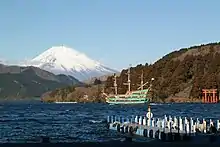 Lake Ashi pirate ship
Lake Ashi pirate ship
References
- "Orientation - Hakone Travel Guide | Planetyze". Planetyze. Retrieved 2017-06-28.
- Hakone Tourist Association (2018-08-17). "Hakone`s Yosegi Wood Art". Hakone Portal Website. Hakone Tourist Association. Retrieved 2018-08-17.
Hakone Yosegi Zaiku can be described as inlaid wood artistry. No dyes or stains are used, rather the artisans choose from the many different types of trees in the area to create different colors and textures in their art. The Hakone Yosegi Zaiku are characterized by their intricate and complex geometric patterns made from bonding and cutting different types of wood.
- "Hear the Evangelion theme song as you drive over Hakone's Ashinoko Skyline "musical road"". SoraNews24. 2015-04-13. Retrieved 2018-04-18.
- "List of 2018 Japan Anime Tourism 88-Stop Pilgrimage Locations — Jotaku Network". Jotaku Network. 2017-08-30. Retrieved 2018-04-18.
- "Japanese Anime 88-Spots (2018 Edition)". 一般社団法人アニメツーリズム協会-アニメ聖地88. Retrieved 2021-01-24.
- "Evangelion x Hakone 2020: Stations, Spas and More "Evangelion-ized" as Resort Town Becomes "Tokyo-3"". nippon.com. Mar 6, 2020.
External links
| Wikimedia Commons has media related to Hakone, Kanagawa. |
![]() Hakone travel guide from Wikivoyage
Hakone travel guide from Wikivoyage
- Official Website (in Japanese)
- Hakone Portal Website
 Geographic data related to Hakone at OpenStreetMap
Geographic data related to Hakone at OpenStreetMap
